Cyber Security and its Impact on IoT and Social Media
VerifiedAdded on 2023/04/08
|5
|929
|287
AI Summary
This document discusses the impact of cyber security on IoT and social media. It explores vulnerabilities, threats, and the ethical use of data. Additionally, it explains how companies profit from offering free samples and services.
Contribute Materials
Your contribution can guide someone’s learning journey. Share your
documents today.
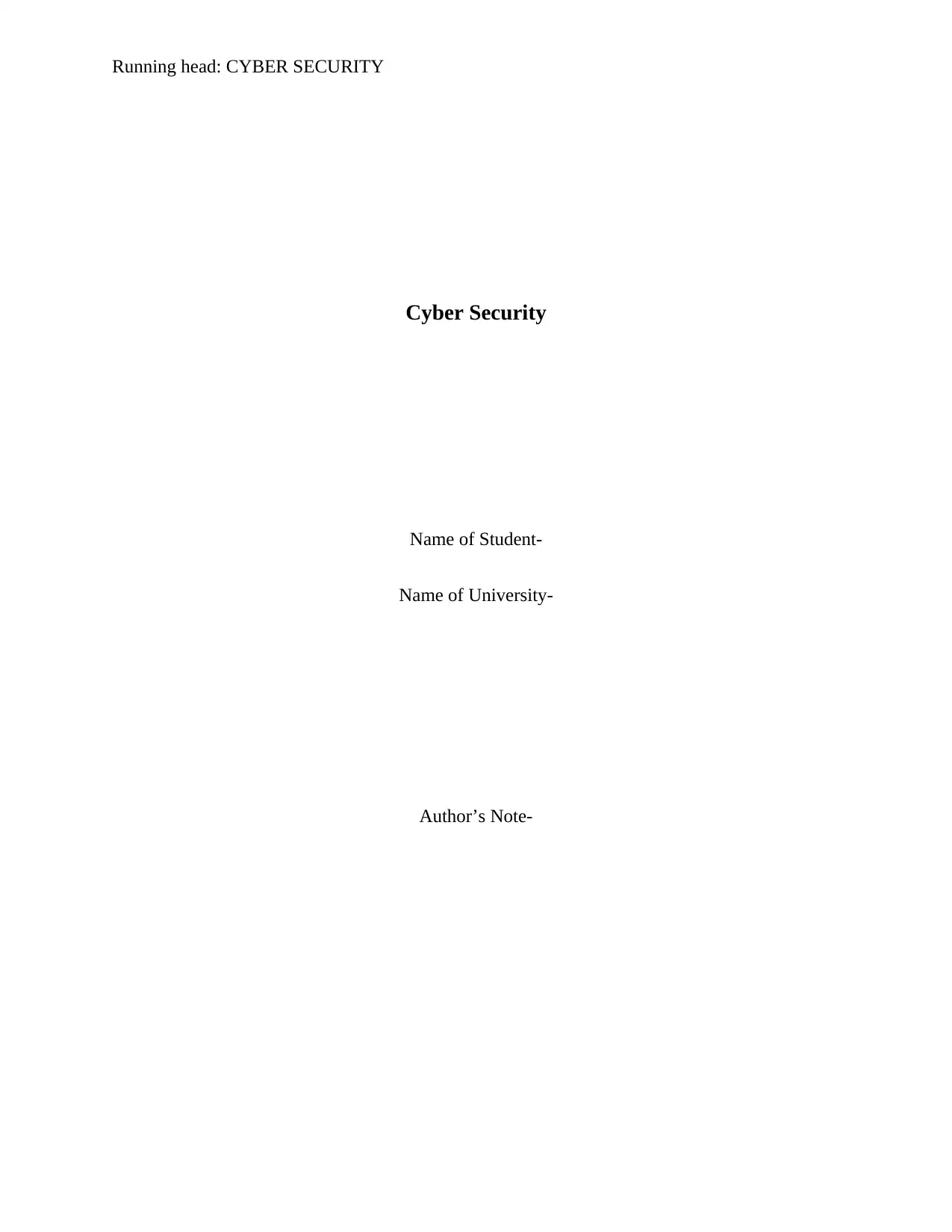
Running head: CYBER SECURITY
Cyber Security
Name of Student-
Name of University-
Author’s Note-
Cyber Security
Name of Student-
Name of University-
Author’s Note-
Secure Best Marks with AI Grader
Need help grading? Try our AI Grader for instant feedback on your assignments.
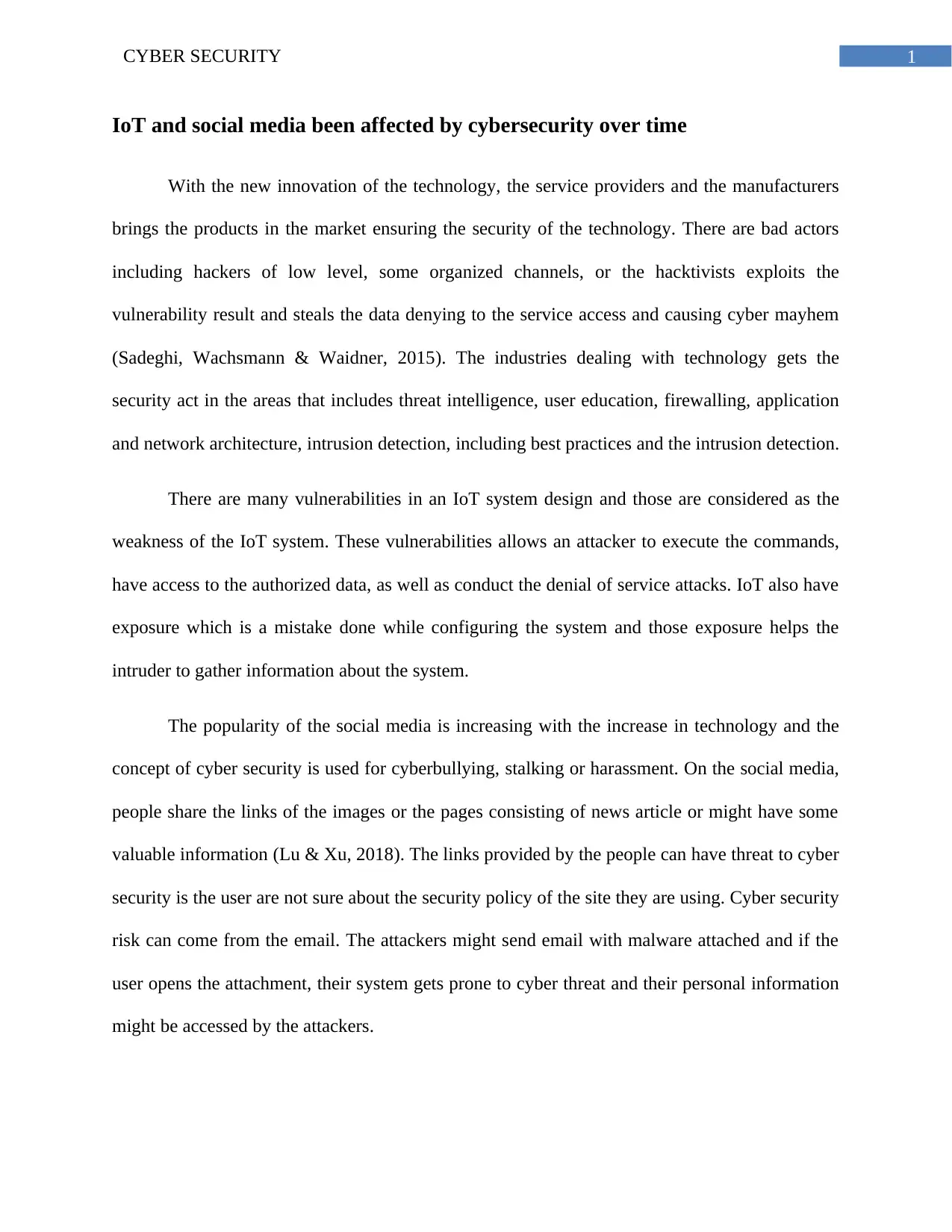
1CYBER SECURITY
IoT and social media been affected by cybersecurity over time
With the new innovation of the technology, the service providers and the manufacturers
brings the products in the market ensuring the security of the technology. There are bad actors
including hackers of low level, some organized channels, or the hacktivists exploits the
vulnerability result and steals the data denying to the service access and causing cyber mayhem
(Sadeghi, Wachsmann & Waidner, 2015). The industries dealing with technology gets the
security act in the areas that includes threat intelligence, user education, firewalling, application
and network architecture, intrusion detection, including best practices and the intrusion detection.
There are many vulnerabilities in an IoT system design and those are considered as the
weakness of the IoT system. These vulnerabilities allows an attacker to execute the commands,
have access to the authorized data, as well as conduct the denial of service attacks. IoT also have
exposure which is a mistake done while configuring the system and those exposure helps the
intruder to gather information about the system.
The popularity of the social media is increasing with the increase in technology and the
concept of cyber security is used for cyberbullying, stalking or harassment. On the social media,
people share the links of the images or the pages consisting of news article or might have some
valuable information (Lu & Xu, 2018). The links provided by the people can have threat to cyber
security is the user are not sure about the security policy of the site they are using. Cyber security
risk can come from the email. The attackers might send email with malware attached and if the
user opens the attachment, their system gets prone to cyber threat and their personal information
might be accessed by the attackers.
IoT and social media been affected by cybersecurity over time
With the new innovation of the technology, the service providers and the manufacturers
brings the products in the market ensuring the security of the technology. There are bad actors
including hackers of low level, some organized channels, or the hacktivists exploits the
vulnerability result and steals the data denying to the service access and causing cyber mayhem
(Sadeghi, Wachsmann & Waidner, 2015). The industries dealing with technology gets the
security act in the areas that includes threat intelligence, user education, firewalling, application
and network architecture, intrusion detection, including best practices and the intrusion detection.
There are many vulnerabilities in an IoT system design and those are considered as the
weakness of the IoT system. These vulnerabilities allows an attacker to execute the commands,
have access to the authorized data, as well as conduct the denial of service attacks. IoT also have
exposure which is a mistake done while configuring the system and those exposure helps the
intruder to gather information about the system.
The popularity of the social media is increasing with the increase in technology and the
concept of cyber security is used for cyberbullying, stalking or harassment. On the social media,
people share the links of the images or the pages consisting of news article or might have some
valuable information (Lu & Xu, 2018). The links provided by the people can have threat to cyber
security is the user are not sure about the security policy of the site they are using. Cyber security
risk can come from the email. The attackers might send email with malware attached and if the
user opens the attachment, their system gets prone to cyber threat and their personal information
might be accessed by the attackers.
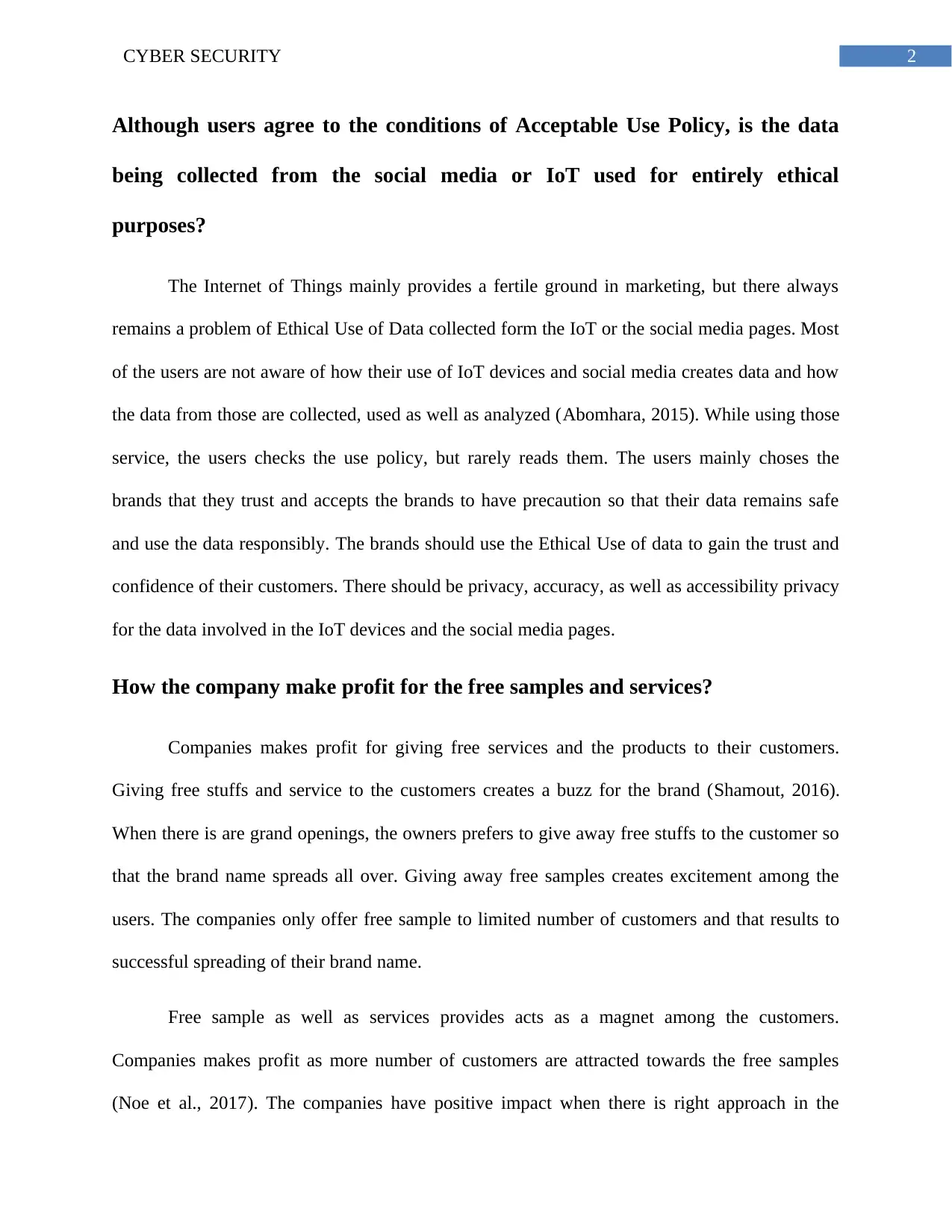
2CYBER SECURITY
Although users agree to the conditions of Acceptable Use Policy, is the data
being collected from the social media or IoT used for entirely ethical
purposes?
The Internet of Things mainly provides a fertile ground in marketing, but there always
remains a problem of Ethical Use of Data collected form the IoT or the social media pages. Most
of the users are not aware of how their use of IoT devices and social media creates data and how
the data from those are collected, used as well as analyzed (Abomhara, 2015). While using those
service, the users checks the use policy, but rarely reads them. The users mainly choses the
brands that they trust and accepts the brands to have precaution so that their data remains safe
and use the data responsibly. The brands should use the Ethical Use of data to gain the trust and
confidence of their customers. There should be privacy, accuracy, as well as accessibility privacy
for the data involved in the IoT devices and the social media pages.
How the company make profit for the free samples and services?
Companies makes profit for giving free services and the products to their customers.
Giving free stuffs and service to the customers creates a buzz for the brand (Shamout, 2016).
When there is are grand openings, the owners prefers to give away free stuffs to the customer so
that the brand name spreads all over. Giving away free samples creates excitement among the
users. The companies only offer free sample to limited number of customers and that results to
successful spreading of their brand name.
Free sample as well as services provides acts as a magnet among the customers.
Companies makes profit as more number of customers are attracted towards the free samples
(Noe et al., 2017). The companies have positive impact when there is right approach in the
Although users agree to the conditions of Acceptable Use Policy, is the data
being collected from the social media or IoT used for entirely ethical
purposes?
The Internet of Things mainly provides a fertile ground in marketing, but there always
remains a problem of Ethical Use of Data collected form the IoT or the social media pages. Most
of the users are not aware of how their use of IoT devices and social media creates data and how
the data from those are collected, used as well as analyzed (Abomhara, 2015). While using those
service, the users checks the use policy, but rarely reads them. The users mainly choses the
brands that they trust and accepts the brands to have precaution so that their data remains safe
and use the data responsibly. The brands should use the Ethical Use of data to gain the trust and
confidence of their customers. There should be privacy, accuracy, as well as accessibility privacy
for the data involved in the IoT devices and the social media pages.
How the company make profit for the free samples and services?
Companies makes profit for giving free services and the products to their customers.
Giving free stuffs and service to the customers creates a buzz for the brand (Shamout, 2016).
When there is are grand openings, the owners prefers to give away free stuffs to the customer so
that the brand name spreads all over. Giving away free samples creates excitement among the
users. The companies only offer free sample to limited number of customers and that results to
successful spreading of their brand name.
Free sample as well as services provides acts as a magnet among the customers.
Companies makes profit as more number of customers are attracted towards the free samples
(Noe et al., 2017). The companies have positive impact when there is right approach in the
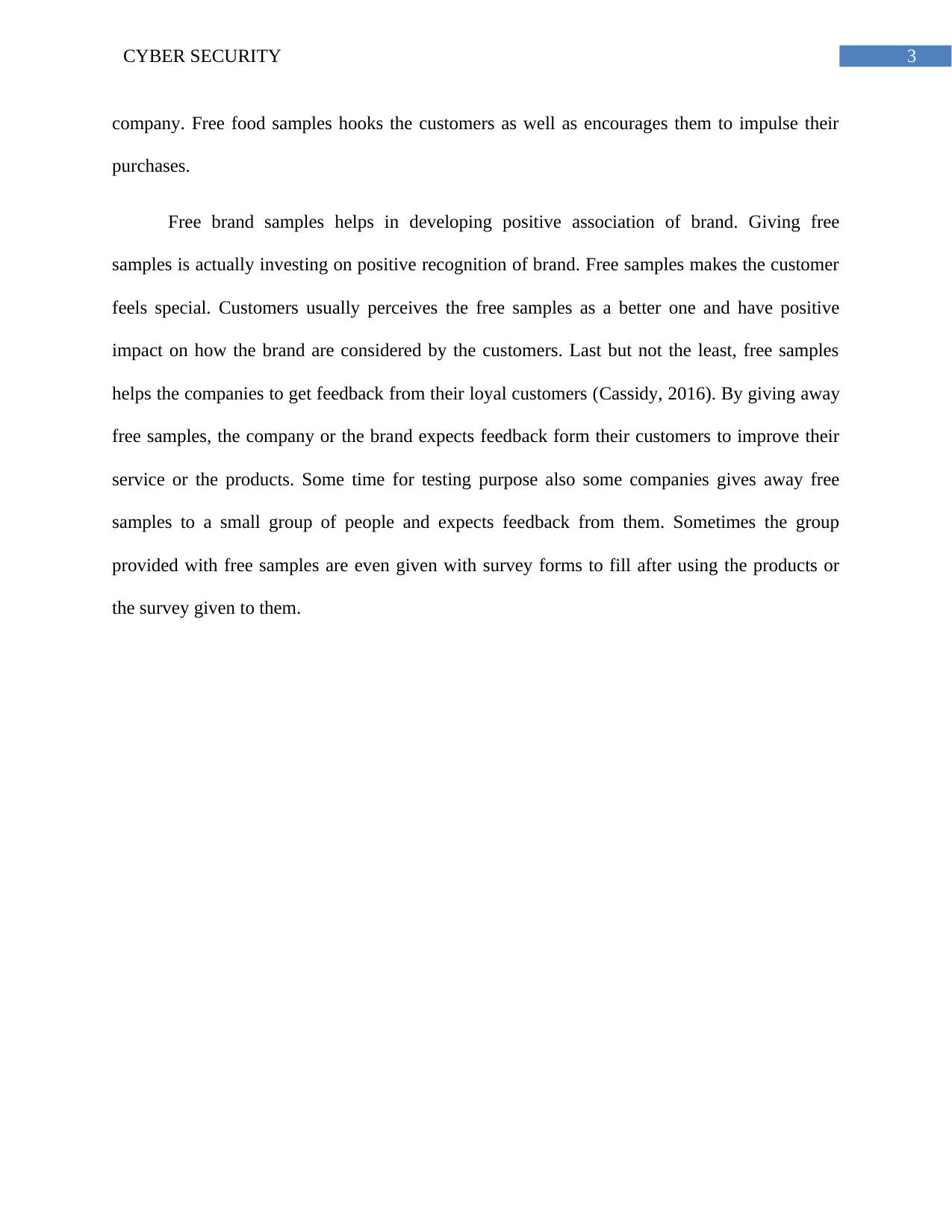
3CYBER SECURITY
company. Free food samples hooks the customers as well as encourages them to impulse their
purchases.
Free brand samples helps in developing positive association of brand. Giving free
samples is actually investing on positive recognition of brand. Free samples makes the customer
feels special. Customers usually perceives the free samples as a better one and have positive
impact on how the brand are considered by the customers. Last but not the least, free samples
helps the companies to get feedback from their loyal customers (Cassidy, 2016). By giving away
free samples, the company or the brand expects feedback form their customers to improve their
service or the products. Some time for testing purpose also some companies gives away free
samples to a small group of people and expects feedback from them. Sometimes the group
provided with free samples are even given with survey forms to fill after using the products or
the survey given to them.
company. Free food samples hooks the customers as well as encourages them to impulse their
purchases.
Free brand samples helps in developing positive association of brand. Giving free
samples is actually investing on positive recognition of brand. Free samples makes the customer
feels special. Customers usually perceives the free samples as a better one and have positive
impact on how the brand are considered by the customers. Last but not the least, free samples
helps the companies to get feedback from their loyal customers (Cassidy, 2016). By giving away
free samples, the company or the brand expects feedback form their customers to improve their
service or the products. Some time for testing purpose also some companies gives away free
samples to a small group of people and expects feedback from them. Sometimes the group
provided with free samples are even given with survey forms to fill after using the products or
the survey given to them.
Secure Best Marks with AI Grader
Need help grading? Try our AI Grader for instant feedback on your assignments.
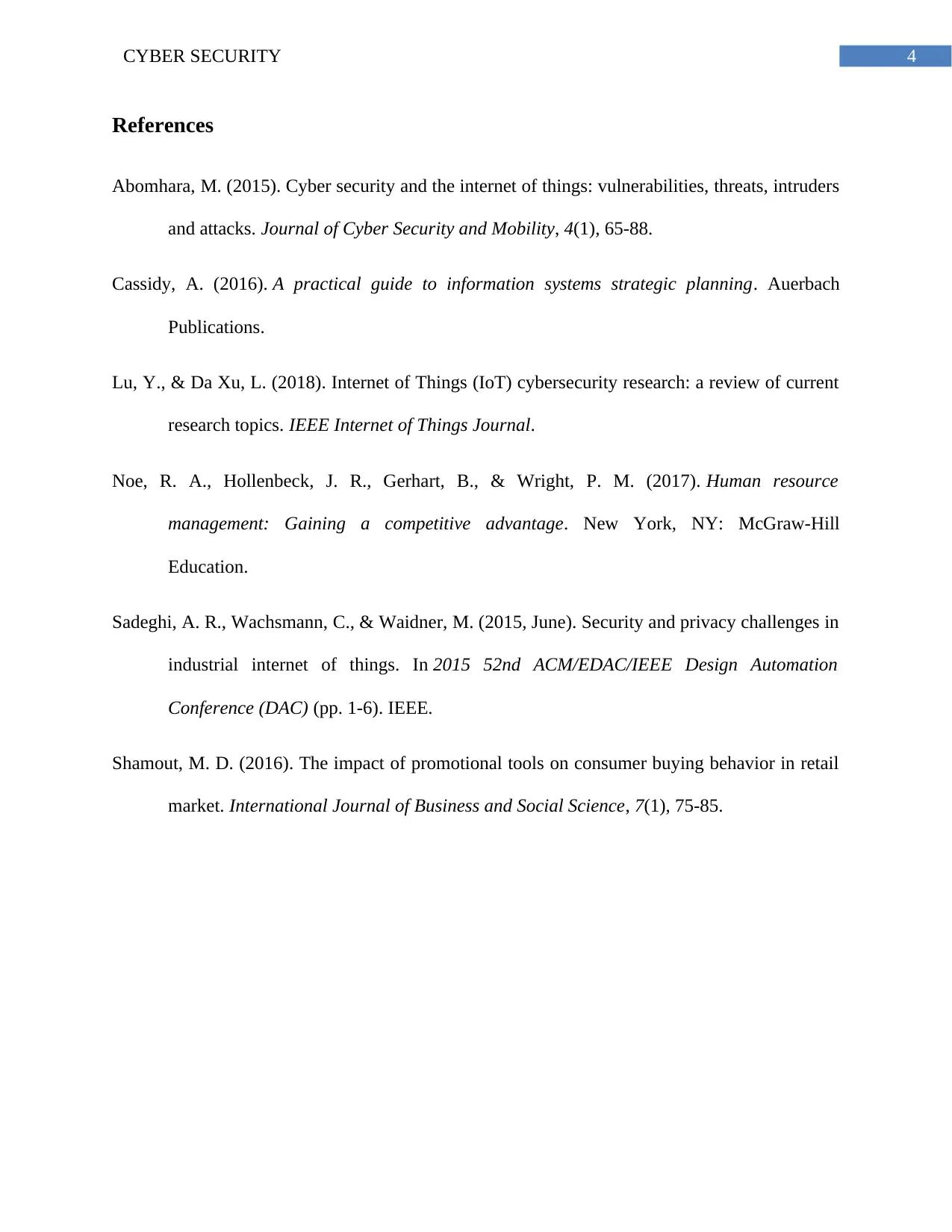
4CYBER SECURITY
References
Abomhara, M. (2015). Cyber security and the internet of things: vulnerabilities, threats, intruders
and attacks. Journal of Cyber Security and Mobility, 4(1), 65-88.
Cassidy, A. (2016). A practical guide to information systems strategic planning. Auerbach
Publications.
Lu, Y., & Da Xu, L. (2018). Internet of Things (IoT) cybersecurity research: a review of current
research topics. IEEE Internet of Things Journal.
Noe, R. A., Hollenbeck, J. R., Gerhart, B., & Wright, P. M. (2017). Human resource
management: Gaining a competitive advantage. New York, NY: McGraw-Hill
Education.
Sadeghi, A. R., Wachsmann, C., & Waidner, M. (2015, June). Security and privacy challenges in
industrial internet of things. In 2015 52nd ACM/EDAC/IEEE Design Automation
Conference (DAC) (pp. 1-6). IEEE.
Shamout, M. D. (2016). The impact of promotional tools on consumer buying behavior in retail
market. International Journal of Business and Social Science, 7(1), 75-85.
References
Abomhara, M. (2015). Cyber security and the internet of things: vulnerabilities, threats, intruders
and attacks. Journal of Cyber Security and Mobility, 4(1), 65-88.
Cassidy, A. (2016). A practical guide to information systems strategic planning. Auerbach
Publications.
Lu, Y., & Da Xu, L. (2018). Internet of Things (IoT) cybersecurity research: a review of current
research topics. IEEE Internet of Things Journal.
Noe, R. A., Hollenbeck, J. R., Gerhart, B., & Wright, P. M. (2017). Human resource
management: Gaining a competitive advantage. New York, NY: McGraw-Hill
Education.
Sadeghi, A. R., Wachsmann, C., & Waidner, M. (2015, June). Security and privacy challenges in
industrial internet of things. In 2015 52nd ACM/EDAC/IEEE Design Automation
Conference (DAC) (pp. 1-6). IEEE.
Shamout, M. D. (2016). The impact of promotional tools on consumer buying behavior in retail
market. International Journal of Business and Social Science, 7(1), 75-85.
1 out of 5
Related Documents
Your All-in-One AI-Powered Toolkit for Academic Success.
+13062052269
info@desklib.com
Available 24*7 on WhatsApp / Email
![[object Object]](/_next/static/media/star-bottom.7253800d.svg)
Unlock your academic potential
© 2024 | Zucol Services PVT LTD | All rights reserved.





